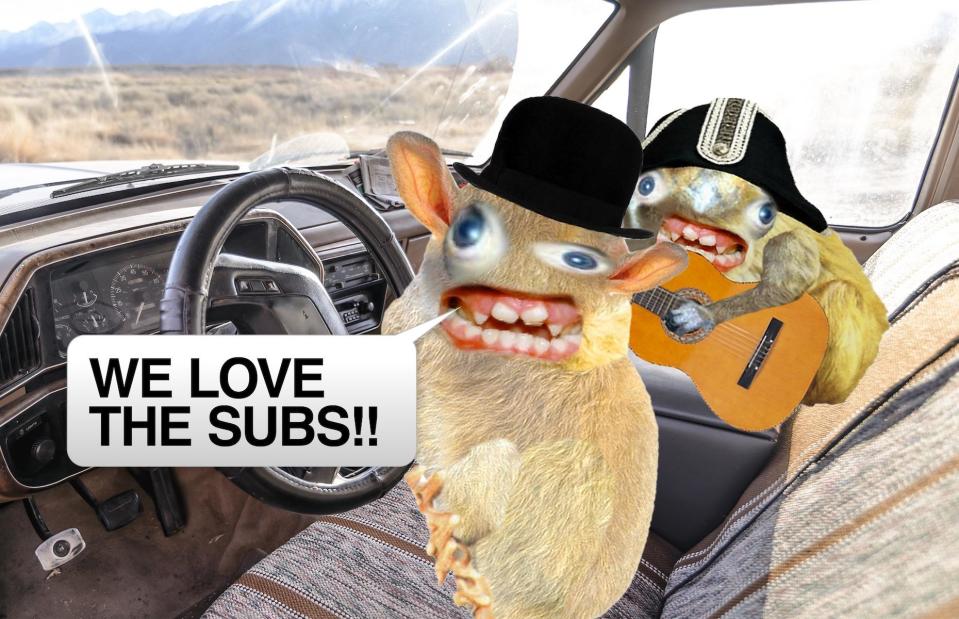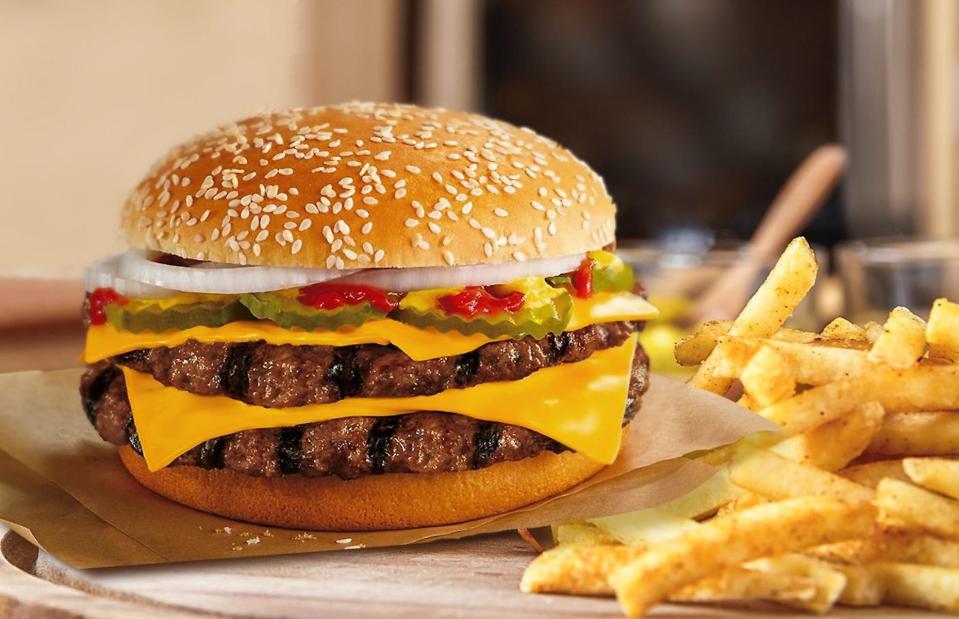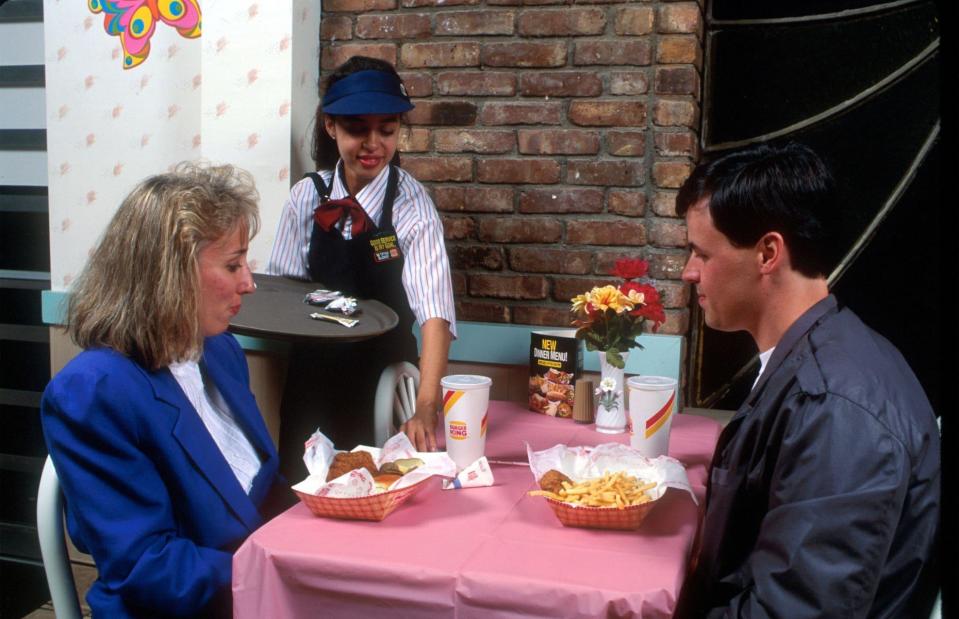RANKED: the most cringeworthy fast food fails of all time
Fast food chains’ biggest mistakes, ranked

Mike Mozart/Flickr/CC BY 2.0
They say you learn more from your failures than your successes. If that’s true, these fast food chains have learned a lot over the years. How do you recover when your ‘genius’ marketing plan inadvertently costs the company millions? Or when a generous promotion turns out to be a little too generous, sparking customer chaos and leading to massive revenue losses? Our countdown guides you through the biggest marketing missteps and most outrageous flops in fast food history.
Read on to find fast food chains' biggest fails, counting down to the worst of them all...
Our ranking is based on the reaction to the mistakes at the time of their release as well as the resulting impact on the business. This list is unavoidably subjective.
25. The McHotDog

McDonald’s/Watch Mojo/YouTube
Ray Kroc, the former CEO and co-founder of McDonald’s, strictly refused to let the chain sell hot dogs during his tenure. “There’s no telling what’s inside a hot dog’s skin, and our standard of quality just wouldn’t permit that kind of item,” Kroc explained in his 1977 autobiography, Grinding It Out: The Making Of McDonald’s. But after Kroc passed away, McDonald’s went ahead and sold McHotDogs in select outlets in the 1990s and 2000s. Turns out, Kroc was right: customers didn’t want them.
24. KFC ran out of... chicken

Matt Cardy/Getty Images
In 2018, 700 of KFC’s 900 UK outlets were forced to close after the chain ran out of – wait for it – chicken. KFC had just changed suppliers from Bidvest to DHL, and DHL suddenly suffered ‘operational issues’ that left KFC stores chicken-less. Chicken-crazy fans went clucking mad, and the news made unwanted headlines for days. In the end, KFC managed to reopen the outlets inside of a week and apologised to its customers. “A chicken restaurant without any chicken. It’s not ideal,” they admitted.
23. McDonald’s Szechuan sauce

Michael Saechang/Flickr/CC BY-ND 2.0
McDonald’s sold Szechuan sauce for a limited time in 1998 to tie in with the animated movie Mulan. Then… nothing. That is, until a 2017 episode of animated sitcom Rick and Morty brought the sauce vividly back into the public consciousness. Fans of the show – and the sauce – demanded its return. McDonald’s granted their wish in October of that year, but the chain only offered a small amount of the sauce at limited outlets. The result? A lot of disappointed fans, chaotic crowds and a major social media outcry.
22. A&W Restaurants' Third Pound Burger

A&W Restaurants/YouTube
In the 1980s, A&W Restaurants took on McDonald’s mighty Quarter Pounder burger. Its answer? The Third Pound burger. Despite being heavier than the Quarter Pounder, the Third Pound was priced the same as its more famous rival. A&W also got behind the new burger with an aggressive ad campaign and a catchy slogan: ‘Third is the Word’. Yet customers were somehow convinced that a third of a pound was less than a quarter of a pound and, therefore, didn’t want any of it.
21. Burger King's Rebel Whopper

Michael Thomas/Getty Images
When Burger King included its first plant-based burger on UK menus in 2020, it seemed like the perfect opportunity to bring vegans and vegetarians to the chain. There was just one problem: the Rebel Whopper isn’t suitable for vegans and vegetarians. This is because it’s cooked on the same grill as regular Whoppers and is served with mayo. The Vegan Society called it a ‘missed opportunity’, and the social media backlash was long and loud.
20. Quiznos' Spongmonkeys

Quiznos/Rathergood/YouTube
How do you describe the Spongmonkeys? They’re bizarre hamster/potato/human mash-ups that weirdly became the mascots for Quiznos in 2004. Plenty of people adored the crazy sub-loving critters, but most Quiznos fans were confounded. The chain reportedly received 30,000 complaints about the Spongmonkeys commercials, with franchisees and customers equally bewildered. The critters didn't reverse Quiznos' fortunes, either. The company eventually closed 4,000 outlets and filed for bankruptcy in 2014. Still, Quiznos and Spongmonkeys did try to make a comeback in 2023.
19. #McDStories

René Sinn/Wikimedia Commons
Social media is the Wild West of advertising campaigns, and things can go very wrong very quickly. McDonald’s found this out in 2012, when it launched its doomed #McDStories campaign on Twitter. The intention was to encourage customers to tell heartfelt tales of time spent beneath the Golden Arches. Unfortunately, not everybody got the memo, and commenters immediately began using the hashtag to criticise the chain. McDonald’s had to remove it two days later.
18. Long John Silver’s Big Catch

Clare Politano/Center for Science in the Public Interest
In May 2013, US chain Long John Silver’s launched the Big Catch platter, piled with a large haddock, onion rings and hush puppies – all battered and deep fried. Just two months later, the Center for Science in the Public Interest (CSPI) labelled it the ‘worst restaurant meal in America’. The problem? The Big Catch contained nearly 1.2oz (33g) of trans fats – a whopping 15 times the maximum daily intake recommended by the World Health Organisation. Unsurprisingly, Long John Silver’s discontinued the Big Catch shortly after the news made nationwide headlines.
17. Burger King's Halloween Whopper

Mike Mozart/Flickr/CC BY 2.0
The Halloween Whopper was a good idea – on paper. This October 2015 treat was a regular Whopper with a season-appropriate black bun. But the treat soon seemed like a trick when confused customers reported that their stool had turned a shocking shade of green after eating the burgers. Experts said the food colouring Burger King used to turn the bun black wasn’t properly absorbed during regular digestion. BK fans said 'No, thank you', and the burger hasn’t returned to the menu since.
16. Taco Bell's Cool Ranch Doritos Locos Tacos

Willis Lam/Flickr/CC BY-SA 2.0
Taco Bell was riding high off the wave of its super-successful Nachos Cheese Doritos Locos Tacos when it announced the arrival of Cool Ranch Doritos Locos Tacos. Fans couldn’t wait to get their hands – and mouths – on them. But when, in 2013, Taco Bell said the eagerly anticipated tacos would launch one day earlier than planned, the fans’ love turned to crushing disappointment. The early launch was only in select locations and many taco-less customers voiced their anger on social media. Taco Bell ended up making a grovelling apology.
15. McDonald’s McDLT

McDonald's/Dave's Archives/YouTube
The McDLT’s USP was that it was served in a large, purpose-built polystyrene container with two compartments. In one side, you had the bottom bun with a burger on it. In the other, you had the top bun with your lettuce, cheese and tomato on it. This was so consumers could ‘keep the hot side hot, and the cool side cool’ until they smashed the two halves together. But this USP proved to be its fatal flaw. By the 1990s, polystyrene packaging was ditched in favour of more environmentally friendly wrappers. Pictured is the 1985 ad starring Jason Alexander, best known for his role as George Costanza in the sitcom Seinfeld.
14. Shake Shack's crinkle-less fries

Jonathan Lin/Flickr/CC BY-SA 2.0
Shake Shack has done little wrong since its launch in 2004, but there was a time in 2013 when things looked a little, well, shaky. Former CEO Randy Garutti demanded the chain start using fresh fries instead of frozen ones – even though the frozen crinkle-cut fries were bestsellers. Garutti’s thinking was Shake Shack should extend its fresh-is-best ethos to its whole range. However, sales of fries tanked after the switch to fresh, and people complained that they wanted their ridged fries back. It took six months, but Garutti eventually caved and brought back the crinkles.
13. Burger King's Ribs

Jason Lam/Flickr/CC BY-SA 2.0
With the 2010 launch of its fire-grilled ribs, Burger King fell victim to that old truism that failing to plan is planning to fail. The problem was that the chain didn’t anticipate how much BK fans would go mad for its new ribs. Burger King shifted 10 million of the items in record time, leaving outlets with no packaging and, eventually, no ribs. The chain had to apologise to customers, adjust its advertising campaign and shut down the promotion early. Perhaps unsurprisingly, ribs have yet to reappear on menus.
12. Oprah overwhelmed KFC

Maryland GovPics/Wikimedia Commons/CC BY 2.0 & Biswarup Ganguly/Wikimedia Commons/CC BY 3.0
Underestimate Oprah Winfrey at your peril. In 2009 Winfrey partnered with KFC to give her audience an offer they couldn’t refuse. For 24 hours, fans could go to her website and download a voucher for a free grilled chicken meal at KFC. The response was, KFC later admitted, "unprecedented and overwhelming". Fans downloaded 10.5 million coupons and KFC gave away $42 million (£33m) of free chicken. Lines and wait times got so bad that KFC stopped the promotion ahead of time and introduced a raincheck offer instead.
11. McDonald's super-sized meals

Jeff Kravitz/Getty Images
McDonald’s started offering the super-sized meal as early as 1987, and they eventually felt an almighty backlash in 2004. That’s when documentarian Morgan Spurlock (pictured) released the impactful Super Size Me, in which he ate only McDonald’s food for 30 days. The movie led to increased debate about America’s eating habits and more scrutiny of McDonald’s menus. Just six weeks after Super Size Me came out, McDonald’s announced it was scraping the super-size option. A spokesperson said the decision had “nothing to do with that [film] whatsoever”.
10. Burger King's Satisfries

Saul Loeb/Getty Images
Burger King proudly announced the arrival of its Satisfries in September 2013. The fast food chain had spent 10 years developing a special batter that meant these crinkle-cut fries had 20% fewer calories than those offered by McDonald’s. They called it ‘one of the biggest fast food launches’ in history and presumably waited for the cash to roll in. Unfortunately, BK customers roundly rejected the 'healthier' deep-fried potatoes, and Satisfries were removed from most of Burger King’s US stores less than a year after their launch.
9. Carl's Jr.'s burger commercials

Carl's Jr./ M+AD/YouTube
They say sex sells, but that’s not the case if you’re Carl’s Jr./Hardee’s. From 2005, the company produced numerous commercials featuring famous, scantily clad women suggestively devouring its burgers. “I like beautiful women eating burgers in bikinis,” former CEO Andy Puzder once said. “I think it’s very American.” But many customers didn’t agree. In 2015 (a year after an ad with Sports Illustrated model Hannah Ferguson, pictured, and Paris Hilton first aired), a poll by advertising research firm Ameritest revealed that 51% of people polled found the ads ‘irritating and annoying’. The chain abandoned the campaign in 2017.
8. McDonald’s Arch Deluxe

PatrickRich/Flickr/PDM 1.0
In hindsight, the Arch Deluxe was a major misstep from the very start. McDonald’s spent a year in the mid-1990s developing its ‘burger with the grown up taste’ to appeal to older customers. The company reportedly splashed $200 million (£158m) on advertising this new, premium burger and projected it would make them a return of $1 billion (£790m). Alas, older patrons weren’t interested, and casual diners didn’t want to pay the high – for 1996 – price of up to $2.49 (around £2). The Arch Deluxe is now remembered as one of the biggest flops in McDonald’s history.
7. Pizzaland's penny for a pizza promise

Newcastle Libraries/Flickr/PDM 1.0 & Pizzaland/CandleMusicLondon/YouTube
Pizzaland hasn’t been a thing in the UK since 1996 – partly because of its ‘penny for a pizza’ promotion. The chain had around 140 outlets at its peak but struggled to retain its customers by the mid-1980s. That’s when the owners enticed in new crowds with coupons in newspapers that allowed pizza lovers to buy one pizza and get another for, you guessed it, a penny. The promotion worked at first, but it eventually devalued the pizza in fans’ eyes and led to the downfall of the business.
6. Popeyes' chicken sandwich

Popeyes
Popeyes had been in the chicken game for a long time when, in 2019, it launched its take on the chicken sandwich. This was such a major event for fast food fans that the meal has been christened ‘the sandwich that broke the internet’. The US launch of the sando saw hungry customers lining up around the block for a taste – only to be left hangry when the chains ran out of stock. The demand "far exceeded our very optimistic expectations", Popeyes said in a statement. The chain had to work very hard to get it back in stores to appease its fanbase.
5. Burger King tried table service

Yvonne Hemsey/Getty Images
In 1992, Burger King dared to do what no other fast food chain would: it offered table service. Between 4-8pm each day, customers could order their food at the counter and then retreat to a table laid with cutlery and napkins. There was even free popcorn to sample while they waited. Five to seven minutes later, servers would also bring out the food. BK hoped to change older people’s minds about fast food diners and attract new fans. But a year later, they pulled the plug on the failed scheme and went back to basics.
4. Domino’s The Noid

Domino's Pizza/RetroCommercial.com/YouTube
When The Noid appeared as Domino’s mascot in 1986, he was an almost inexplicable hit. The character inspired two video games and loads of merchandise for fans eager to ‘avoid the Noid’. But three years later, everything changed. In 1989, 22-year-old Kenneth Lamar Noid held up a Georgia-based Domino’s outlet and took two hostages. Noid, a paranoid schizophrenic, believed Domino’s ad campaign was targeted specifically at him. The hostage situation de-escalated after five hours, but the ordeal marked the demise of the once-popular pizza mascot.
3. McDonald’s McAfrika

TT News Agency/Alamy & Sardaka/Wikimedia Commons/CC BY 3.0
Norwegian McDonald’s outlets launched the McAfrika in 2002, and it did not go well. They chose the name because, McDonald’s said, the beef pitta sandwich was based on an African recipe. Critics didn’t see it that way, though, and accused the chain of cultural insensitivity. It was particularly galling that the sandwich was released in one of the world’s wealthiest nations when there were 12 million people fighting starvation in Africa. McDonald’s compromised by allowing aid agencies to promote fundraising in its restaurants.
2. Burger King's Where’s Herb? commercials

Burger King/DatCommercial/YouTube & Mike Mozart/Flickr/CC BY 2.0
In late 1985 and early 1986, Burger King plunged $40 million (£31.5m) into its ‘Where’s Herb?’ advertising campaign, which invited customers to visit restaurants and find the elusive Herb, ‘the one man who has never tasted a Burger King burger’. But the messaging proved confusing for casual diners and potentially offensive to men named Herb. “It did not work nearly as well as I hoped,” Burger King President Jay Darling told the Chicago Tribune newspaper. Burger King’s profits tanked by 40% in 1985, and the chain switched ad agencies shortly afterwards.
1. McDonald’s 1984 Olympics promotion

McDonald's/UnitedWeBrad/X & Mcdonalds/Dan Matthews/YouTube
If the USA won a medal at the 1984 Olympics, McDonald’s promised that fans with matching event cards would earn free Big Macs, fries or drinks. It was a cute gimmick – until the Russians dropped out of the Games and the promotion caused a frenzy at the Golden Arches. The US went on to win a staggering 174 medals, 83 of which were gold. Some McDonald’s outlets soon found themselves running low on Big Macs. The chain has never revealed the cost of giving away all that free food, but The New York Times newspaper called it ‘mind-boggling’.


